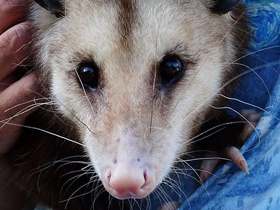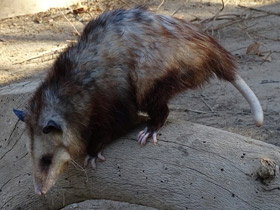The Virginia opossum or the North American opossum (Didelphis virginiana)
The Virginia opossum (Didelphis virginiana), also known as the North American opossum, is the only opossum living north of Mexico, its range extending south into Central America. It is the northernmost marsupial in the world. In the United States and Canada, it is typically called a possum. It is a solitary nocturnal animal about the size of a domestic cat, and a successful opportunist.
Opossums are familiar to many North Americans as they frequently inhabit settled areas near food sources like trash cans, pet food, compost piles, gardens or housemice. Their slow, nocturnal nature and their attraction to roadside carrion make opossums more likely to become roadkill.
Name
The Virginia opossum is the original animal named "opossum", a word which comes from Algonquian wapathemwa, meaning "white animal". Colloquially, the Virginia opossum is frequently just called a "possum". The name opossum is applied more generally to any of the other marsupials of the families Didelphidae and Caenolestidae. The generic name (Didelphis) is derived from Ancient Greek: di, "two", and delphus, "womb".
The possums of Australia, whose name derives from their similarity to the opossums of the Americas, are also marsupials, but of the order Diprotodontia.
The Virginia opossum is known in Mexico as tlacuache, tacuachi, and tlacuachi, from the Nahuatl word tlacuatzin.
The Virginia opossum, northern opossum, Virginia opossum, American opossum, North American opossum, tacuacin, or simply opossum or mykure (Didelphis virginiana) is a species of didelphimorphic marsupial in the family Didelphidae. It is the only marsupial in North America.
Origin
The generic name "opossum" comes from "wapathemwa", the name of the Virginia opossum in an Algonquian language. The name was later assigned to all members of the genus opossum (Didelphimorphia). The scientific name of the genus Didelphis has Greek roots: di (two) and delphys (uterus, womb), and is due to the fact that female opossums, like all other marsupials, have a double uterus. The Latinised name of the species virginiana means "from Virginia", as it was in Virginia that the first specimen of the Virginia opossum was found and described.
Appearance
Didelphis virginiana is a relatively dense and heavy mammal, about the size of a domestic cat. Body length varies from 33 to 55 cm, tail length from 25 to 54 cm, weight of an adult animal varies from 1.9 to 6 kg, with males being larger and heavier than females (males typically weigh between 2.1 and 2.8 kg, females between 1.9 and 2.1 kg).
The snout of Didelphis virginiana is elongated and pointed, with long vibrissae. The ears are relatively short, naked, black, with lighter tips. The limbs are short, with 5 toes each.
The thumb of the hind limbs lacks a claw and is strongly opposed to the others. The plants of Didelphis virginiana are naked, the tail is almost naked, long, grasping, adapted for climbing. The colouring of the fur and skin of Didelphis virginiana varies according to the region. It is usually greyish, sometimes reddish or brownish. The coat of the muzzle is considerably lighter than the rest of the body (usually greyish white).
The coat is rather long and the undercoat is short and soft. In northern populations, the undercoat is dense, with white hairs, sometimes with black tips; the hairs are grey. In southern populations, the undercoat is rarer and the hairs are darker; in general, southern individuals are darker in colour. The toes and ear tips are lighter in northern populations and darker in southern populations; in the latter, the pigmentation of the tail skin extends beyond the hairy part of the tail.
The skull of these ancient animals is primitive, with a small skull and 50 teeth. Normal body temperature; 35-35.5°C. Normal heart rate is about 200 beats per minute. Didelphis virginiana has one of the lowest basic metabolic rates recorded in mammals.
Habitat
Didelphis virginiana is the only species of marsupial found in the Americas north of the Rio Grande. It ranges from southern Canada (northwestern Ontario) to Mexico and Central America (Guatemala, Belize, El Salvador, Honduras, Nicaragua and Costa Rica). The natural range of the Virginia opossum is from the eastern United States to the Rocky Mountains. When the first settlers arrived in North America, the species was not found north of Pennsylvania, but was discovered in Ontario in 1858 and in New England in 1900.
With the development of agriculture, the Virginia opossum moved westward to the Great Plains; by 1890, it was found in California, and soon inhabited the entire Pacific coast of the United States.
Today, the range of Didelphis virginiana continues to expand northward, although cold weather is limiting this progress.
Didelphis virginiana inhabits a wide variety of habitats, from relatively arid to coastal areas, but generally prefers to stick to wet and wooded areas, especially thickets along the banks of reservoirs and marshes. Didelphis virginiana are easily adapted to the presence of humans. They often rest in tree hollows, piles of dead wood and rubbish, abandoned buildings and underground utilities in populated areas. Rodents do not dig their own burrows, but use the burrows of others, usually occupied by females for nesting. However, the lack of available dens does not limit the distribution of opossums. Didelphis virginiana is mainly terrestrial, but is an excellent climber, using its clawed tail for additional support. In its shelters it builds nests of fresh leaves and grass, using its tail to transport building material.
Lifestyle
Didelphis virginiana is a territorial animal, although it is believed to lead a partially wandering lifestyle, remaining in one area for no more than 6 months. Studies have shown that typical possum habitat is elongated rather than rounded in shape, following the course of a river or stream. They range in size from 0.12 ha to 23.47 ha, but can occupy up to 254 ha.
Didelphis virginiana is solitary; social relationships are poorly developed; except for breeding behaviour, adults are hostile to each other. Although females can be kept in captivity in groups, adult males invariably engage in fights, often resulting in the death of the weaker male. Aggressive behaviour includes aggressive vocalisations (hissing, screeching), teeth baring and physical contact. The weaker opponent may fall into catatonia.
Compared to other mammals, Didelphis virginiana appears rather slow and clumsy. They can run at speeds up to 7.4 km/h, climb with opposable thumbs and a grasping tail, and swim well but slowly (up to 1.1 km/h). They dive in case of danger, easily covering a distance of up to 100m. In case of serious danger, Didelphis virginiana "pretends" to be dead (in fact, this reaction to strong stress is involuntary), but may also show aggressive behaviour. A very frightened opossum enters a cataleptic state, which can last from a few minutes to 6 hours. Pretending to be dead, Didelphis virginiana falls to the ground, curling up and clutching its limbs; it does not react to touch, but lies on its side with its mouth open and tongue out (physiologically this state resembles a human fainting spell). Its muscles are relaxed and its anal glands secrete a foul-smelling greenish secretion.
Didelphis virginiana groom their fur with their hind fingers (except the thumb), combing out parasites. They wash their muzzle with their front paws, like cats.
Didelphis virginiana are active only at night, foraging after sunset. Activity peaks between 11 p.m. and 2 a.m. in spring and summer. Didelphis virginiana spends the day in shelters. In late autumn and winter, activity is greatly reduced, especially during periods of heavy frost, but Virginian opossums do not hibernate. At this time, Didelphis virginiana accumulates fat reserves.
Nutrition
Didelphis virginiana is omnivorous. Insects and other invertebrates make up the majority of its diet. It also eats fruit, crustaceans, snails, worms, frogs, salamanders, dead fish and other carrion, mice, snakes, bird eggs and sometimes even birds and rabbits. In populated areas it easily scavenges through discarded rubbish.
Reproduction
Didelphis virginiana has a long breeding season, lasting from January or February to June-July. Breeding activity peaks between late January and late March and between mid-May and early July. Immediately thereafter, the female becomes aggressive again and chases the male away.
Fertilisation occurs in both uteri, although ovulation may be delayed by 4 days. Each ovary releases an average of 11 eggs and fertilisation takes place in the fallopian tubes. After 24 hours, the fertilised eggs reach the uterus. A placenta does not form, but the embryo is surrounded by the folds of the uterine wall. Pregnancy in Didelphis virginiana lasts 13 days. Didelphis virginiana has 1 young per year in the northern part of its range; in the rest of the range it has 2 young per year, rarely 3. A brood usually consists of 8 to 18 young (although there are cases of 56 young appearing at once); however, the female has only 13 teats, so some of the young do not survive. As a result, when hatchlings emerge from the pouch, their number is usually 8-9 hatchlings in the north and 6-7 in the south.
Didelphis virginiana hatchlings are born very prematurely, weighing only 0.13 g and 14 mm in length. They look more like embryos than mature animals. Immediately after birth, they crawl with the help of the claws developed on their front legs into their mother's pouch, where they attach themselves to the teats. When the calf begins to suckle, the nipple swells and fills its mouth completely. The young remain attached to the teats until they are 50-65 days old, which is comparable to the gestation period of a placental mammal of similar size. Two months after birth, the young develop fur and open their eyes, and in another 5-10 days they begin to move on their own and feed on solid food. At this time, the young climb onto their mother's back, often clinging to her tail, which is raised on her back with the end pointing forward.
Didelphis virginiana calves become independent between 95 and 105 days of age, after which all communication with the mother ceases. Captive females observed in captivity do not protect their young and allow them to be removed from the nest. Young females reach sexual maturity at 9 months of age and rarely live more than one breeding season in the wild. In general, Didelphis virginiana rarely live more than 18 months in the wild; in captivity they may live more than 7 years.

















































